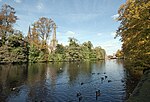Lichfield Record Office
Archives in StaffordshireHistory of StaffordshireLibrary building and structure stubsLichfieldStaffordshire building and structure stubs

Lichfield Record Office held the archives for the City of Lichfield and its immediate vicinity. The archives are held at The Friary, Lichfield, and run by Staffordshire County Council.Lichfield Record Office closed on 1 January 2018 and its collections moved to Staffordshire Record Office.
Excerpt from the Wikipedia article Lichfield Record Office (License: CC BY-SA 3.0, Authors, Images).Lichfield Record Office
The Friary, Lichfield Darwin Park
Geographical coordinates (GPS) Address Nearby Places Show on map
Geographical coordinates (GPS)
| Latitude | Longitude |
|---|---|
| N 52.6815 ° | E -1.8295 ° |
Address
Former Lichfield Library
The Friary
WS13 6QG Lichfield, Darwin Park
England, United Kingdom
Open on Google Maps










